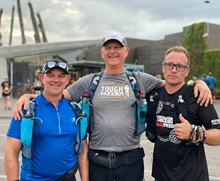Almost there! Please complete this form and click the button below to download now.
Yes please send the EBook..
Congratulaions for signing up! We will get in touch with you shortly

Almost there! Please complete this form and click the button below to download now.


What’s something you’d like to achieve but feels impossible to you right now?
Some things that are so far off your screen, they’re unthinkable… but still somehow attractive. You’d be proud to have achieved. Might even be on your bucket list.
It’s revealing to look inside that vault within us, the one we’ve labelled as ‘The Impossibles’, those things that are currently totally beyond us.
But what if the walls of that vault were actually made of wafer bread? What then might be achievable in your life?
I had such a vault of ‘inconceivable’, ‘unthinkable’, ‘utterly impossible’.
And yes, the above photo is a punch-line spoiler. But let’s unpack some of the vault-melting insights that preceded this this image.
Read moreI’ve always enjoyed sports and fitness but as an incidental. Throughout most of my adult life, I’d go to the gym twice a week for maintenance and a bit of ‘me time’ – not particularly goal-driven.
I was happy to follow Shaun’s (the gym instructor) lead. So when he said, ~10 years ago, we needed more cardio I thought ‘ok’ and we so began, literally running one lamppost, walking the next to get started.
Again, not particularly goal driven.
Eventually this graduated to a regular Sunday morning catch up, just Shaun and I, to run 5 kms followed by a coffee – always a celebratory coffee!
This grew as we challenged each other. More hills. Longer runs. Less walking on the hills. New scenic off-road trails.
Eventually we got up to 10 kms – non-stop, even with hills. We started to enjoy running – felt the relief of a body that was more willing, no longer the recalcitrant, complaining conscript.

We didn’t do any organised events for over two years, until ‘Tough Mudder’. TM was a mid-winter mudfest, where you got electrocuted, swam through ice-mud holes, and ran the hilly 18 km course.
We’d never run that distance. Not even come close, so this was a pinnacle achievement. We tested our outer limits and survived…. and actually thrived; we extended our outer boundaries of possible.
It felt deeply exhilarating.
The question was, what next? This was back in August 2017.
As a parallel side-story, my (and in fact our family’s) life had been shattered by the passing of our beautiful 25 yr old daughter (Danni) in February 2017. A victim of brutal lymphoma cancer.
I was still emotionally raw, floating through life struggling to make sense of what made no sense.
But one thing that anchored me was a promise I made to Danni in our last conversation-of-significance together. She made me promise to ‘Step Up’. A life-commitment I willingly accepted – not knowing the ‘how?’ or what that would form it would take.
This became the new lens / criteria I would look at the world and my life through.
So, when the question of ‘What next?’ arose after Tough Mudder, I had no-idea (I was still barely holding it together) but I knew I didn’t want to lose my fitness.
It was at this point, my good friend and wise running partner Shaun asked, ”What about the Tarawera Ultramarathon, February 2020?” Over two years away.
(An Ultra-marathon is any distance over the usual 42km of a marathon. Tarawera’s annual event has three ‘Ultras’ – 52km, 100km and 160km. Shaun was referring to the 52km).
That thought right there, to run 52km, sat squarely inside in my ‘Impossible’ vault. I’d never run more than 18 km, never conceived of running a marathon… so an ultra?!
Don’t be ridiculous!
In that moment I got to see (and feel) the dimensions of my ‘Impossible vault’, and how impenetrable were the walls – they were even re-enforced with, “It is unethical and immoral to do that to your body. Your body is your temple and deserves to be nurtured, not tortured”.
No way, no how!
I was in massive contradiction. A visceral civil war between fundamental and fiercely held beliefs of deep respect for my body and an obvious path to literally ‘Stepping up’ – my promise to Danni and life itself.
I couldn’t say yes. I needed to process it. I knew I somehow had to do it but I was deeply torn.
It took a full week to reach a quiet ‘yes’, a reasoning that made sense.
Given that I am in the business of personal development and releasing potential, I would become my own incubator.
I would use this training period (the 2.25 years) to observe myself as I undertook the deliberate journey from ‘impossible’ to ‘possible’.
I’d note what was needed, what barriers arose, what worked, and what didn’t.
Essentially, it was to identify crucial insights, the ingredients for just such an article as this.
It was a highly plausible and rational reason – and one that has served me.
But here’s the thing, it wasn’t the real reason.
If I’m honest, the more compelling reasons were:
In our running team of three, the other two had already said yes. I didn’t want to be the odd-man out. (Oh, the power of exclusion!)
With the decision made, our gradual training was steadily undertaken and on 8 February 2020 we completed the ‘impossible’ Tarawera 52km ultra marathon. In the above picture, that’s me on the far side, Shaun second from the left.
We ran and finished as we had trained – crossing the finish line together. Our desire to support the other succeed was as strong as our desire to achieve ourselves.
Reverse-engineering ‘Impossible’ – the three essentials
So what were the three essentials to going far beyond anything we had done before?
Recalibrate your Identity
Our identity is how we define ourselves to ourselves. And we act in accordance with that identity.
As Tony Robbins says, “The strongest force in the human personality is the need to remain consistent with you define yourself.”
If you see yourself as a generous person, you will do generous acts.
Initially I saw myself as an occasional runner, I acted and thought accordingly. If I had continued with that identity, I would have undermined my own best intentions and would have had to rely on willpower to ‘gut it out’.
That’s called friction. Ultimately unsustainable.
I needed to move from the type of person who wanted to run a trail ultra, to the sort of person who is an ultra- trail runner.
I recognised this, so I deliberately redefined my identity to: I am an ultra-marathon trail runner.
Does an ultra-marathon runner think differently, train more thoroughly, study running more intently than an occasional runner? Absolutely
Running became part of who I was/am; an identity-based habit and behaviour change.
Every time I trained, I reaffirmed the person I wanted to be in the world – my inner sense of alignment was even more fulfilling than the growing ease of physical conditioning.
I was becoming truer to me.
What is something you want to achieve? I highly recommend deliberately crafting a redefined identity statement around this, one that captures your intent exactly.
The structure of an identity statement is ‘I am a/an [adjective] [noun]’ e.g. I am a trusting leader. I am a gritty ultra-marathon runner.
The more specific you can be, the deeper the self-connection, self-validation and self-contract.
YOUR TURN: What’s yours?
Know Your ‘Why’
Simply by asking ‘why I do what I do?’ moves you towards the first principles of yourself – your core fundamentals.
By answering that question (Why do I do what I do?) and then answering, ‘And why is that important to me?’ you come to know your core motivators.
Motive (reason) is at the core of motivation.
It’s the oomph that will get you out of bed on cold mornings to train, to continue with hill repeats even when your legs feel like jelly.
So, what was my ‘why?’ I had several.
YOUR TURN: So, why do you do what you do? What else? And why is that important to you?
Deliberately select your Tribe
“If you want to go fast, go alone. If you want to go far, go together.” – African proverb
Well, yes and no.
It depends on what’s important to that group – what are their values? Are they the same as yours?
I guess the definition of ‘your tribe’ is those who share the same values. Those you feel ‘at home with.’
But there are nuances when it comes to selecting a tribe to help you achieving the impossible. Two, in fact.
Let’s unpack those.
Point 1: If you want to run 50km, join a group that regularly runs 21km trainings or are in training for 100km ultra. You’ll struggle to keep up initially but it soon normalises
If you’re looking to build your wealth through real estate, join a group of investment property owners.
If we’re the average of the five people we spend most time with, let those people be ‘better’ than you in your chosen endeavour
Point 2: Ideally, you will have a lot more in common with that group than, say, running.
Our running group shared a lot in common: all were business owners, happily married, two kids, had similar political views, were not interested in mediocre.
There was even more ‘glue’ to meeting up. We felt comfortable with each other.
YOUR TURN: So what tribe can you join whose minimum is what you are striving for and you have multiple things in common with?
PS And 12 month’s on…here’s a picture of Shaun, Ricky and I ready to start and then to cross the finish line of our second Tarawera Ultra- (52km) 2021


PPS Shaun and Ricky have just said ‘Yes’ to the 2022 Tarawera 100km! I’m having to reapply all these tools again, to achieve my next ‘Impossible’ with them
If you loved this article, join the weekly newsletter — featuring tips and reflections on leadership development and stress management in the modern world. Join the 5,000+ leaders who have it delivered straight to their inbox each week.

The only thing certain in life (apart from death) is uncertainty. Doesn’t that phrase ring true after the challenges and uncertainties of the pandemic? I’ve seen it with my leadership coaching clients and it’s clearer than ever: chaos and uncertainty are now front and centre in leadership and business.
The best leaders and organizations know how to expect, mitigate, and overcome uncertainty. But do they actually thrive and grow in it? Or are they victims to this ambiguity, struggling to get by.
Emergent leadership utilizes situational decision-making to handle uncertainty and chaos. As part of your leadership development, focus on implementing these three ideas: strategize for uncertainty, understand employee behaviours to draw out strengths, and think in essentials.
Read moreThe first step is realizing that uncertainty needs to be accounted for in organizational strategy. Many leaders see uncertainty and chaos as an anomaly or outlier to their carefully-crafted plans. In reality, they need to be accounted for within strategic planning.
An emergent leader will go beyond a linear plan and look at what can and will go wrong. The military uses the acronym VUCA (Volatile, Uncertain, Complex, Ambiguous) to analyse a scenario and strategize how to approach it.
This mindset can be applied to business and leadership: there will be uncertainty, how do we plan for it?
Organizations typically have an HR strategy that focuses on people and leadership development, and a corporate strategy that focuses on company operations. To adequately address uncertainty, these need to be connected. All people in the organization need to be trained and empowered to make role-appropriate decisions that are in line with the company’s goals.
The second focus area is to build a team that is capable and confident in responding to change. Each team member needs to be able to make decisions and adjust to challenges. It is not sustainable as a leader to make every decision on behalf of your team; you need to empower others to make decisions, too.
To accomplish this, identify the strengths in your team. Everyone has core behaviours – such as flexibility, risk-tolerance, or communication – that are energising, easy to do and they’re good at. If they meet these three criteria, they’re strengths. By taking time to understand and know who is on your team, you can leverage their specific strengths as part of your strategic plan.
Let’s say you’ve engaged in robust leadership training and professional development with your team and know who is a risk taker and who is risk averse. Using this information, you can develop a plan for how each individual should act in certain scenarios and provide a scope of decision-making that is appropriate to their personality and strengths.

The last piece is for leaders to think in essentials. This means reducing the complexity down to a bare, distinct summary of what really matters. By paring down business mission to just three needle-movers, team members can focus on what needs to be done and have the mental capacity to manage chaos.
A practical way to do this is to apply ‘task + why’ Instructions.
If an employee is tasked to do something – say, pick up lunch at the restaurant down the street – they need to be told the purpose, the ‘why.’ This way, if the original restaurant is closed, but they know the budget and type of food to order, they can pivot and make a new choice that still fulfils the purpose. This eliminates the need for excessive leadership input into small decisions and helps incorporate situational decision-making into every business operation.
When you consistently focus on the essentials and are clear on the purpose, you are empowering your team to manage uncertainty and chaos. Instead of constantly putting out fires, you give each team member the tools to put it out themselves, or even prevent it from starting in the first place.
Chaos and uncertainty is no longer an outlier in a leader’s normal business function. Reality shows us that storms are inevitable and leaders need to prepare for them. The best way is to practice situational-decision making and empower their team to do so as well.
By deliberately strategizing for uncertainty, empowering team members through their strengths, and focusing on essentials, leaders can handle and thrive in any storm.
If you loved this article, join the weekly newsletter — featuring tips and reflections on leadership development and stress management in the modern world. Join the 5,000+ leaders who have it delivered straight to their inbox each week.

Have you been struggling with productivity? Or perhaps you are feeling like you just can’t motivate yourself or focus like you used to.
You are not alone! One of the many challenges of this past year was the complete upheaval of the way we work. Many people find it challenging to stay productive and focused while working remotely.
Here are some common experiences leaders are having:
Even as we put COVID-19 in the rear-view mirror, challenges to productivity and focus are bound to follow us throughout our careers. And as a leader, it is even more important to get back on track in order to lead your company and employees well.
So, what can be done? How to re-establish and sustain productivity and focus?
Well, it turns out that current research in the both the ADHD (Attention Deficit Hyperactivity Disorder) and Executive Coaching fields have a lot to tell us about how to fight this lack of focus and attention. These fields use psychology research and study areas of personality and cognition and how they overlap with productivity.
Let’s first identify what the demons of distraction are so you can identify and be aware of them. Here are some common ones:
So, are you ready to slay these demons? Here are some actionable tips to implement right away:

We all struggle with focus, productivity, and attention at times. But the good news is that there are things you can do to address it! Make sure to implement these tips to slay your own demons of distraction, and become the best leader you can be.
If you loved this article, join the weekly newsletter — featuring tips and reflections on leadership development and stress management in the modern world. Join the 5,000+ leaders who have it delivered straight to their inbox each week.

Leaders face constant challenges in the workplace. I bet you can list them with me: financial constraints, competing priorities, stakeholder interests, underperforming employees – the list goes on. This forces us to maximize time and efficiency in the workplace, just to get things done.
But what if that efficiency is keeping you from being the best leader you can be? Or, if the way you interact with staff is keeping them from performing at their best?
When we prioritize efficiency and speed, we might miss something else: authenticity.
A leader being authentic gives safety for team members to also express their authenticity. This, in turn, builds trust, connection and engagement across the team.
Here are some ways to accelerate your leadership development by weaving authenticity into the workplace.
Read moreIf you want a change to stick, it’s got to start from the top. Those in formal positions of leadership hold the status and authority to embed change.
This doesn’t come without risk. It can be risky to become a little less filtered in your speech, and a little more honest and candid. But when it’s managed correctly, others will willingly follow your lead.
It can start small, just by changing the tone of conversations. Consider it part of your leadership training to consciously share about a recent game your favourite team played, or what you were up to with your family on the weekend.
It is important to note that this is not a call to become best friends with people at work, as that can create its own issues. Instead, focus on pulling back the veil and revealing yourself as who you are and what is important to you. The goal is to connect as a person, beyond the titles and responsibilities.
One high-impact sharing starts, “Failing at helped me become a better leader… and here’s how…” This helps you to be more human, more relate-able… and ultimately, more believable.
As a culture of authenticity develops, more people will feel comfortable to speak up with their ideas, opinions, and difficulties. Some may be nervous to speak up, so it’s important to be actively supportive when they deviate from the norm and offer a candid idea or opinion. This applies even if you don't agree with them – you must support that well intentioned effort by staff to speak up if you want it to continue.
After giving them space to speak, validate what they are saying by showing you have heard and understood. This sounds like, “Sam, I like the way that you spoke up and said your mind. If I hear you correctly, what you said is…”
Finally, as a leader, you must cultivate deep curiosity about what your employees have to say. They have ideas and opinions to bring to the table, so stay open-minded and curious about new ideas or initiatives!

At this point, some leaders might be thinking, ‘But doesn’t this take too long?! We can’t afford to waste time talking about personal things.’
It’s true that this approach may take more time. But, as I remind my leadership coaching clients, it all comes down to how you prioritize the time you have.
Many of you will be familiar with the Pareto Principle: the 80-20 rule that states that 80% of outcomes are due to just 20% of inputs. This principle encourages leaders to identify and then prioritize what is most important. In this case, it’s creating an atmosphere that boosts workplace morale, encourages ideas, and maximizes productivity through engagement.
It’s the first essential in creating psychological safety – where it’s safe to share ‘off-the-wall’ ideas, challenge others (and be challenged) and be open with vulnerability.
If you are serious about leadership development and want to infuse authenticity into your workplace, there are really just three simple steps to making it work. First, model authenticity as a leader. Second, validate and affirm those who follow suit and take a step. Finally, prioritize this change in your workplace and leadership. Your employees, your business, and your goals are too important to ignore the power of an authentic, connected, and engaged team.
If you loved this article, join the weekly newsletter — featuring tips and reflections on leadership development and stress management in the modern world. Join the 5,000+ leaders who have it delivered straight to their inbox each week.

Successful leadership has many facets – we know this and see it play out each day. If you are on a leadership development journey, you have inevitably developed multiple practical skillsets to achieve success. However, many leaders neglect the one thing that can make the biggest difference – mindset.
For many, mindset is a blurry concept. So let’s bring it into sharp focus.
You mindset is the lens you see the world through. It is the meaning you make (or your interpretation) of the events you experience. It is how you translate everyday events. The story you make up about the event.
For some, getting constructive feedback is felt as threatening or an attack. For others, it is welcomed as a new perspective to consider and make improvements from. The mindset (or meaning made) about feedback is markedly different.
Read moreThe ripple effects of mindset are enormous… just think of the downstream impact of feeling feedback works against me vs feedback working for me. Challenges happening to me or for me.
Mindset therefore sits right at the core of becoming an unshakeable leader; a leader who is psychologically resilient to changes and challenges. I don’t know about you, but I want to be that kind of leader. It’s something I help my leadership coaching clients achieve and is something you can begin to work on today.
Becoming an unshakeable leader is especially relevant because we live in such turbulent times. Covid was an obvious example. A world-wide, simultaneous wave of turbulence and uncertainty.
But we actually face three pandemics, not one: 1) Covid, 3) financial and 3) mental illness – the psychological echo of that turbulence.
We all feel the effects as stress, anxiety, and uncertainty. So why, then, do some leaders and organizations thrive, while others fail? How is it some develop and grow and become unstoppable?
Research shows us that mindset can make all the difference.
We know that those with a positive or growth mindset are more resilient to change, seeing it as an opportunity to develop, tighten up processes and procedures, and get back to their core values. On the flip side, those with a negative or closed mindset can buckle under the pressures and challenges they face.
To change your mindset into a positive, growth-oriented, and open one is not a simple snap of the fingers. Leadership development does not come without hard work. Luckily, there are a few key areas of focus that will allow you utilize mindset in becoming a better leader.

Though 2020 may be behind us, leaders know we face accelerating change (aka disruption). To become an unshakeable leader, resilient and able to succeed in this volatile environment, requires a training of the mind. Cultivating an open, growth-oriented mindset will truly make the difference and propel you towards the goal of becoming the unshakeable leader (and parent) you want (and need) to be.
If you loved this article, join the weekly newsletter — featuring tips and reflections on leadership development and stress management in the modern world. Join the 5,000+ leaders who have it delivered straight to their inbox each week.

One of the most significant leadership mistakes you can make is underestimating the cruciality of the so-called "soft skills." In leadership your team takes their behavioural cues from you. So, it's vital that you communicate effectively, yet sensitively, at every level.
It’s your soft skills — also known as emotional intelligence (EI), that sets the tone throughout your whole company / team. Developing your emotional intelligence, enhances your relationships with staff and thus your business’ resilience.
If you’re experiencing people issues in your company, it’s your soft skills that will solve them.
Read moreSoft skills are the people, social and communication skills that allow you to interact with others daily. Competencies that make up your EI include self-awareness, emotional awareness, confidence, motivation, stress management, adaptability, empathy, social and cultural understanding, coaching, mentorship and conflict resolution.
As a leader, it's vital that you develop these skills to enhance your leadership style, inspire the best out of your team and, ultimately, increase profits.
According to world-renowned leadership coach Nada Nasserdeen, business surveys show that a staggering 82% of professionals struggle with confidence in the workplace. A considerable number of leaders and team members have difficulty communicating effectively and managing their emotions at work.
Poor EI skills see people struggling with imposter syndrome, having difficulty reading other people's reactions and unintentionally giving off nonverbal signals that turn their co-workers away.
You may have outstanding qualifications, but your career will flounder if you don't have the soft skills to manage others. Likewise, if you lack motivation and the ability to communicate effectively, your technical qualifications may be rendered useless.
Discovering which of your soft skills need improving means you'll have to tackle your ego first. It's challenging and emotionally draining to face your faults head-on. After all, few people are comfortable with outright criticism. However, to improve your leadership skills, you first need to know where your team feels you're going wrong.
The softer option is to survey your team — or widen the net to include all your stakeholders. Crucially, the answers must be completely anonymous. Few employees will give honest feedback if they fear it will come back to bite them.
Let people know WHY you're asking them to complete the survey. Emphasise that you want their honest opinions — especially where they feel you could improve. Use variety, including multiple-choice, short answer, and word list questions that ask about strengths and weaknesses in the team, company, and leadership strengths and weaknesses.

The more direct route (and far more engaging) is to simply ask your stakeholders, “How can I be a better leader for you?” and whatever they say, reply with, “That’s interesting, tell me more.”
Nothing beats direct human interaction. Take notes and get back to them in a couple of weeks’ time with an update of what you have taken up.
Your PBOD comprises five people who have your back but are not afraid to make the hard calls when you need them to. They come from all walks of life, but you can turn to them for feedback you can trust.
These five board members are:
Use your PBOD for the honest feedback you need to improve. These coaches help you develop the strength of purpose you'll need to build your people-and-leadership skills.
Once you've received your survey results and discussed them with your PBOD, it's time to get to work on improving your people skills.
Some questions you may consider are:
Like any other skill, it takes effort and lots of practice to develop and improve your people skills to become an effective leader. But the effort pays off enormously because a happy and productive business culture starts at the top — with you!
If you loved this article, join the weekly newsletter — featuring tips and reflections on leadership development and stress management in the modern world. Join the 5,000+ leaders who have it delivered straight to their inbox each week.

As a human species, our progress has evolved out from a biology (and psychology) that craves community. We are innately social and emotional creatures, and for great communication, it’s crucial to understand this as a leader.
In practical leadership development terms, what does this look like?
A common mistake leaders make is thinking of communication as logic. We’re a complicated species, needing more than a well-made point to win us over. Instead, deeper connection comes from the trust and loyalty built through an emotional connection.
Read moreInsert emotions into your communications. “I understand this will be frustrating.” “In the last three months, the effort I has seen has been inspiring.” etc
Emotion, unlike logic, is controlled by the limbic system of the brain, - the fight / flight / freeze part of the brain. Naming emotions enhances a sense of inclusion and connection.
Essential for your leadership development training, is to recognise the integral part your failings / vulnerability plays in your ‘superhero’ origin story. What connects us to Superman is not his laser beam eyes, but it’s a backstory we can all get behind.
The important part in your hero-story, is your WHY? What brought you to dedicate yourself to this (what you’re doing now)? Why do you now care so deeply?
The story needn’t be written as an international best-seller, just authentically relate-able with every-day people. This story is like a trip on Aladdin’s magic carpet and allow others to connect with you through your ups and downs.
Mirror neurons enable us to feel what a character in a film is going through. They are the science behind us travelling the same path and feeling / mirroring the same feelings.
Story is the way to establish your emotional credibility as a leader.
Revealing fear and vulnerability through your story is what calls to that emotional connection our brains crave..
To use vulnerability as a tool in your leadership training, it’s important this is authentic.
These 3 points help ensure this:

Especially within the virtual world Covid has created, many have lost motivation and focus. Key to your leadership development and team performance is acknowledging your team. Why are they working so hard? What are they achieving? Tell them!
Focus on the bigger picture. If you lead a law firm, remind your team, “This typing is more than just earning them a salary; your work changes lives.”
If you walk into a room with energy, that energy spreads. If you show amazing work, those around you do the same. Mirror neurons in action.
Your example is crucial, and the team is a reflection of your leadership.
Compelling communication, as a leadership tool, revolves around one thing our brains are biologically hard-wired to follow: emotion.
You tap into this by, firstly, knowing and creating your origin story that shows WHY you care and, secondly, using your vulnerability to express an authentic message. This, in turn, establishes the behaviours to be modelled.
If you loved this article, join the weekly newsletter — featuring tips and reflections on leadership development and stress management in the modern world. Join the 5,000+ leaders who have it delivered straight to their inbox each week.

As a leader, you make many repetitive decisions every day. This can lead to cruising on autopilot, which is not the best way to steer your organization or company!.
Cultivating deep self-awareness within your leadership development is essential to help make conscious decisions that are the best for you and your company, not resorting to the easiest.
What if you self-reflect and find yourself approaching business or organizational issues on autopilot or with a defensive, “This is the way it’s always been done.”? The cut-through you seek is via curiosity, observation, and self-awareness.
Read moreThe ability to self-observe and ask why you make a decision is an important skill for leaders and the first step to getting out of autopilot.
One way to get clarity on why you do things the way you do, is to recognize your default patterns.
There are a variety of personality tests used in leadership coaching that can help you identify your motivations, triggers, stressors, or habits. The Enneagram, for example, is a personality model that helps people identify the motivations behind their actions. It can help you recognize those default patterns you use in different scenarios.
There are other personality tests such as Myers-Briggs or DiSC that are also useful for leadership training.
But even if you don’t use a personality test, you can still take some intentional time for self-reflection. Start with these questions:
Another way to cultivate deep self-awareness is to distinguish between facts and the stories.
We see someone leaving a meeting early, for example – and we attribute a story to it (It’s something we have made up). Perhaps we think they are taking a personal phone call, making a coffee, or just bored with the meeting.
Reality is, all you know is the fact that they left and didn’t come back.
Now, using stories to understand our observations is human nature. But if you use that information to then take action before knowing the full story, it can create real challenges.
For example, the manager may reprimand the employee for leaving early. However, the reality was that this employee had a family emergency that required attention. Now the relationship and trust between that employee and manager is affected.
So, be alert to, and self-reflective of, the conclusions (stories) you’re ascribe to situations. Stick to the facts. Try to suspend judgement until you know more about a situation then you can make the right decision to handle it.

Learning about your own personality and understanding the difference between facts and stories are the first steps in building self-awareness. Here are some other actions you can take in your leadership training to cultivate this skill:
As a leader, you’re making decisions all the time. Your personality, motivations, and constant repetition of issues and problems mean that you are likely to go into autopilot mode when dealing with them. The solution to breaking this pattern is to cultivate deep self-awareness about how and why you take certain actions.
Leadership development requires you to be self-aware because a self-aware leader is an effective leader. It will also serve you well at home.
If you loved this article, join the weekly newsletter — featuring tips and reflections on leadership development and stress management in the modern world. Join the 5,000+ leaders who have it delivered straight to their inbox each week.

Information overload and disruption often renders us, as leaders, feeling overwhelmed, and dispirited; unsure of our next step. Covid, as an example, has not been a ‘wind of change’, more an overwhelm-tornado.
A bad thing?
The inconvenient truth of leadership development is: the growth we seek occurs fastest during uncomfortability. Leading is learning. Discomfort is our friend. Pain is a catalyst.
The greater question, therefore, is how to experience discomfort yet remain intact and on-target. How to grow through and with discomfort? How to engage BRAVE-LY
Read moreThe BRAVE method is a great tool for executives and leaders to strengthen your sense of control.
What lies on the other side of your discomfort / your fear?
The first step in your leadership training is to pause, project forward, and consider about how you want to feel in life, both professionally and personally. What do you want people to be saying about you in 12-24-36 months?
Next, you will probably feel an inner resistance, maybe even an inner conflict at that prospect. These are your fears around this. What are those limiting beliefs, those constricting fears?
But you’ve got this! You’ve overcome these fears before. Recall when. You have a bank of relevant, resourceful experiences.
This is all about realising you already have the inner resources, the proven capability to prevail.
Breaking fear down removes its power, and means your leadership can look beyond this inner barrier to build a roadmap to your greater life.
Step into the learning zone (a 5-10% nudge)
Next, actively choose to step 5 – 10% into the discomfort zone. Beyond that is the ‘overwhelm’ zone. Applying the BRAVE formula can help with this.
Boundaries
As a leader, what are your present outer limits, your outer boundaries of comfort?
This isn’t referring to etiquette boundaries.
These are your leadership growth boundaries… where, when you think about them, you move into, “I’m not sure I could be that good / go that far / be that extraordinary.”
Get clear, identify them. Is it leading a team of 2 or 10 or 20? Running a project (or an organisation) of $2m, $10m or $150m? Challenging someone by 2% or 10% or 100%?
Where does your inner resistance kick in? Then lean in by 10%
Review (to Reframe for Resilience)
Review for reassessment. Assess what to keep, what to change. The Reframe: no mistakes, only learnings.
Resilience (your ability to bounce back) comes from the refresh and reset you feel from this process.
In practice, a leader should have a daily, weekly, monthly, quarterly, and annual schedule of Review to ask the important questions. What systems are working? What to develop? Communication style? Boundaries?
Action, Accountability
Be intentional that you have this schedule. There can be no review without taking Action, ideally bold action.
Achieving extraordinary is too big for just one person – we need help. This is where Accountability partnering works so well.
Weekly connection that asks 1) What did you say you were going to do? 2) What didn’t you do? 3) Why not? 4) What support is needed? 5) Smallest next steps?
Vulnerability
Don’t be afraid to ask questions, and understand that, even as a leader, you cannot know everything. Your team is there to work together and help each other.
Work from the premise that, “I might not know the answer, but together we can find it”
Empowerment
Empowerment is the growth of confidence that sees you extending your learning and succeeding as a leader.

1. A healthy gratitude practice
This is a scientifically proven method to decrease stress, anxiety, and depression, while also increasing overall happiness and wellbeing.
All it takes is regularly sharing 3 things you’re grateful for, plus saying why. After 3 weeks of this, you help your brain to rewire, putting you back in control.
As a leader, you should build this process into your team talks, and communication process as a whole.
2. Next-day planning
Another great tip for leadership coaching is planning. Before finishing the day, take some time to reflect on what is needed to achieve your goals, and set out a timed schedule of how you can do this.
This makes sure you’re taking action, prevents time-wasting, and can clear a full mind.
3. Ask for help
A common mistake made by leaders, or anyone, is that they can go it alone. This is not useful, and asking for help shows strength, builds relationships and shows an important level of vulnerability.
In summary, it only takes small steps organise your inner focus and lean into your discomfort zone. Apply this to your team to help them identify their boundaries, reviewing, and planning their nudged growth. Together, these steps will be training your leadership, helping you to keep control, and giving you the confidence of an empowered leader.
If you loved this article, join the weekly newsletter — featuring tips and reflections on leadership development and stress management in the modern world. Join the 5,000+ leaders who have it delivered straight to their inbox each week.